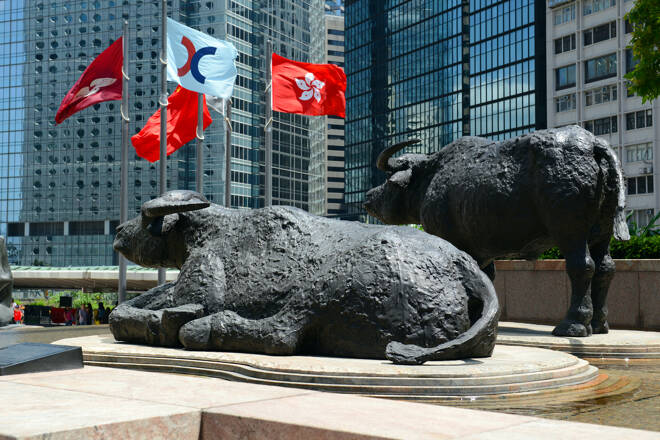Advertisement
Advertisement
Hang Seng Index, ASX200, Nikkei 225: US CPI Report in Focus
By:
It will likely be a choppy Thursday for the Hang Seng Index and the broader markets, with US inflation angst likely to test buyer appetite.
Key Insights:
- It was a mixed Wednesday session, with the Hang Seng Index and the ASX 200 making modest gains while the Nikkei saw red.
- Consumer price inflation and producer price index numbers from China delivered modest support.
- This morning, investors will likely be cautious, with the US CPI Report in focus later in the day.
It was a mixed Wednesday session for the Hang Seng Index and the broader Asian markets. The Hang Seng Index and the ASX 200 made modest gains, while the Nikkei saw red.
There were no overnight economic indicators from the Tuesday US session to influence. Investors brushed aside Fed chatter ahead of the US CPI Report. FOMC member Patrick Harker suggested the Fed may be at the end of the monetary policy tightening cycle. Hotter-than-expected inflation numbers could force the Fed doves to rethink their position.
However, China consumer price inflation figures and producer price index numbers supported the ASX 200 and the Hang Seng Index.
Consumer prices fell by 0.3% year-over-year in July after stalling in June. Economists forecast a 0.4% decline, signaling weak consumer demand. However, consumer prices increased by 0.2% in July, reversing a 0.2% decline in June. Economists forecast a 0.1% increase.
However, the producer price index fell by 4.4% year-over-year, following a 5.4% decline in June. Economists forecast a 4.1% decline.
While the producer price index declined at a less marked pace in July, the 4.4% fall reflected the ongoing weakness in global demand, aligned with the July Caixin manufacturing PMI and the latest import and export figures. Nonetheless, a possible bottoming out and a pickup in consumer prices should provide some comfort.
The NASDAQ Composite Index fell by 1.17% on Wednesday. The Dow and the S&P 500 saw losses of 0.54% and 0.70%, respectively.
The Day Ahead
Today, there are no Asian economic indicators to influence, leaving investors to consider the heavily anticipated US CPI Report out later in the day. Hotter-than-expected inflation numbers would reignite bets on a September Fed interest rate hike, which could refuel recessionary jitters.
ASX 200
The ASX 200 gained 0.37% on Wednesday, with the inflation numbers from China providing support.
ANZ Group (ANZ) and Westpac Banking Corp (WBC) saw gains of 0.75% and 1.66%, respectively. However, The Commonwealth Bank of Australia (CBA) and The National Australia Bank (NAB) led the way, rallying 2.58% and 2.18%, respectively. CBA announced a full-year profit of A$10.2 billion on Wednesday, buoying the rest of the big-4.
Mining stocks had a mixed session, with Fortescue Metals Group (FMG) and BHP Group Ltd (BHP) ending the day up 0.19% and 0.40%, respectively. Newcrest Mining (NCM) gained by 0.50%, while Rio Tinto (RIO) fell by 0.54%.
Oil stocks had a bearish session. Woodside Energy Group (WDS) and Santos Ltd (STO) fell by 0.29% and 0.13%, respectively.
Hang Seng Index
The Hang Seng Index partially recovered the China trade data-induced losses, gaining 0.32% on Wednesday.
Considering the main Index components, Tencent Holdings Ltd (HK:0700) and Alibaba Group Holding Ltd (HK:9988) saw gains of 0.72% and 1.13%, respectively.
Bank stocks had a mixed session. HSBC Holdings PLC fell by 0.23%. However, The Industrial and Commercial Bank of China (HK:1398) and China Construction Bank (HK: 0939) ended the day up 0.56% and 0.94%, respectively.
CNOOC (HK: 0883) rose by 1.11%.
Nikkei 225
(For reference purposes only)
The Nikkei 225 bucked the trend on Wednesday, falling by 0.53%. Caution ahead of the US CPI Report left the Nikkei in the red, with Softbank Group and Daikin Industries (6367) contributing to the losses.
The banks had a bearish session. Sumitomo Mitsui Financial Group (8316) and Mitsubishi UFJ Financial Group saw losses of 1.68% and 3.05%, respectively.
Looking at the main components, SoftBank Group Corp. (9984) fell by 3.13% on disappointing earnings, with Fast Retailing Co (9983) ending the day with a 0.21% loss. However, Sony Corp (6758) and Tokyo Electron Limited (8035) saw gains of 0.08% and 0.31%, respectively, while KDDI Corp (9433) ended the session flat.
Check out our economic calendar for economic events.
About the Author
Bob Masonauthor
With over 28 years of experience in the financial industry, Bob has worked with various global rating agencies and multinational banks. Currently he is covering currencies, commodities, alternative asset classes and global equities, focusing mostly on European and Asian markets.
Advertisement
